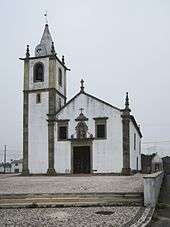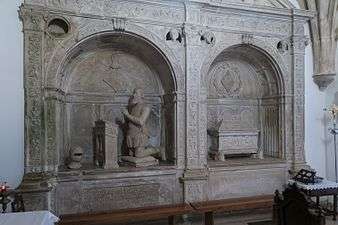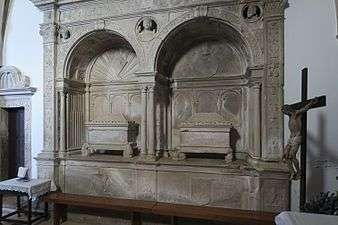Church of São Salvador (Trofa)
| Church of São Salvador (Igreja de São Salvador) | |
| Parochial Church of Trofa, Chapel and Pantheon of the Lemos | |
| Church (Igreja) | |
| Official name: Capela e Panteão dos Lemos/Igreja Paroquial de Trofa/Igreja de São Salvador | |
| Named for: Trofa | |
| Country | |
|---|---|
| Region | Centro |
| Subregion | Baixo Vouga |
| District | Aveiro |
| Municipality | Águeda |
| Location | Trofa, Segadães e Lamas do Vouga |
| - coordinates | PT 40°36′39.1″N 8°28′42.8″W / 40.610861°N 8.478556°WCoordinates: PT 40°36′39.1″N 8°28′42.8″W / 40.610861°N 8.478556°W |
| Architects | Diogo de Castilho, João de Ruão |
| Styles | Gothic, Renaissance, Mannerism |
| Owner | Portuguese Republic |
| For public | Public |
| Easiest access | Rua D. Duarte Lemos |
| Management | Instituto Gestão do Patrimonio Arquitectónico e Arqueológico |
| Operator | DRCCentro[1] |
| Status | National Monument Monumento Nacional |
| Listing | Decree 16 June 1910, Diário do Governo, 136, 23 June 1910 |
| Wikimedia Commons: Igreja da Trofa | |
The Church of São Salvador (Portuguese: Capela e Panteão dos Lemos/Igreja Paroquial de Trofa/Igreja de São Salvador) is a church in the civil parish of Trofa, Segadães e Lamas do Vouga, in the municipality of Águeda, in the Portuguese Centro district of Aveiro.
History

In 1499, King D. Afonso V made Gomes Martins de Lemos the master of Trofa. In 1522, Duarte de Lemos ordered the construction of a funerary chapel in the parish of Trofa.[2]
Between 1536 and 1539, the parietal tombs and statuary were constructed.[2]
Between the 18th and 19th century the main body of the church was constructed.[2]
In 1978, one of the legs of the "praying" statue was encountered broken.[2]
On 1 June 1992, the property fell under the authority of the IPPARInstituto Português do Património Arquitetónico (Portuguese Institute for Architectural Patrimony), by decree 106F/92 (Diário da República, Série 1A, 126).[2][3]
A conditional approval was obtained on 16 November 1998, from the civil parish authority of Trofa and municipality of Águeda, to expand and redefine the size of the churchyard.[2]
In 2006, the parochial church of Trofa do Vouga was closed to the public since August, in order to precede with work to conserve, restore and promote the religious heritage; work began on 17 August 2006, then concluded in April 2007.[2]
Architecture
The church is located in the town of Trofa, in an small, isolated churchyard slightly arborized and enclosed by wall, separating it from agricultural lands.[2]
The plan of the church includes a long nave, with laterally-addorsed rectangular bell tower and sacristy, and covered in ceiling tile.[2] The simple facade includes a portico crowned by niche, that includes statue and surmounted by simple cross, that two lateral friezes and a frontispiece, with corners in stones.[2] The rectangular belltower, two-registers high, is topped by a conical ceiling, and includes a clock. The church is illuminated through windows located laterally along the nave and from the high choir.[2]
Interior
The interior, comprised an unique nave with vaulted ceiling, with five framed sections that includes plastered decoration, and extends to architrave.[2] Above two columns is high-choir in wood with balustrade, with a common access that provides access to the bell-tower.[2] There are also two lateral doorways, a wood pulpit and two collateral retables with architrave decorated in wood.[2]
The main chapel shelters four arcosoliums linked by two structures that uniquely divided by two arches, covering three urns and ornate state.[2]
The two tombs (to the left) are decorated with three medallions and busts, above arches with four columns and archivolts.[2] The entabulature of the two tombs are covered individually-decorated, triangular caps, with central medallion. Above these structures are two large windows, with semi-circular decoration in the interior.[2]
The front of the retable consists of a two-register gilded wood structure with paintings under a central arch, that includes columns, statuary and three sections with semi-circular decoration.[2] The design, which is sectional, is decorated with sculpted forms, that include heraldic symbols, vegetation, anthropomorphic, mythological and military forms.[2]
References
Notes
- ↑ Ordinance 829/2009, Diário da República, Série 2, 163 (24 August 2009)
- 1 2 3 4 5 6 7 8 9 10 11 12 13 14 15 16 17 18 19 Alçada, Margarida; Ruão, Carlos; Costa, Anouk (1998), SIPA, ed., Capela e Panteão dos Lemos/Igreja Paroquial de Trofa/Igreja de São Salvador (IPA.00001042/PT020101180001) (in Portuguese), Lisbon, Portugal: SIPA – Sistema de Informação para o Património Arquitectónico, retrieved 3 October 2016
- ↑ "Igreja de Trofa compreendendo os túmulos dos Lemos". igespar.pt (in Portuguese). Instituto de Gestão do Património Arquitectónico e Arqueológico. Retrieved 2 February 2014.
Sources
- Lacerda, A. de (1928), O Panteão dos Lemos (in Portuguese), Porto, Portugal
- Baptista, A. de Sousa (1946), A capela dos Lemos na Trofa (in Portuguese), Aveiro, Portugal: Arquivo de Aveiro
- Gonçalves, A. Nogueira (1959), Inventário Artístico de Portugal (in Portuguese), Lisbon, Portugal
- Correia, Azevedo (1975), Arte Monumental Portuguesa (in Portuguese), 1, Porto, Portugal, pp. 26–27
- Borges, Nelson Correia (1980), João de Ruão, Escultor da Renascença Coimbra (in Portuguese), Coimbra, Portugal
- Craveiro, Lurdes (1990), Diogo de Castilho e a arquitectura da Renascença em Coimbra (in Portuguese), Coimbra, Portugal
- Dias, Pedro (1995), "Odart Framçes Imaginario: dúvidas e certezas acerca de um escultor do Renascimento Ibérico", Actas do VII Simpósio Hispano-Português de História da Arte (in Portuguese), Cáceres, Portugal



